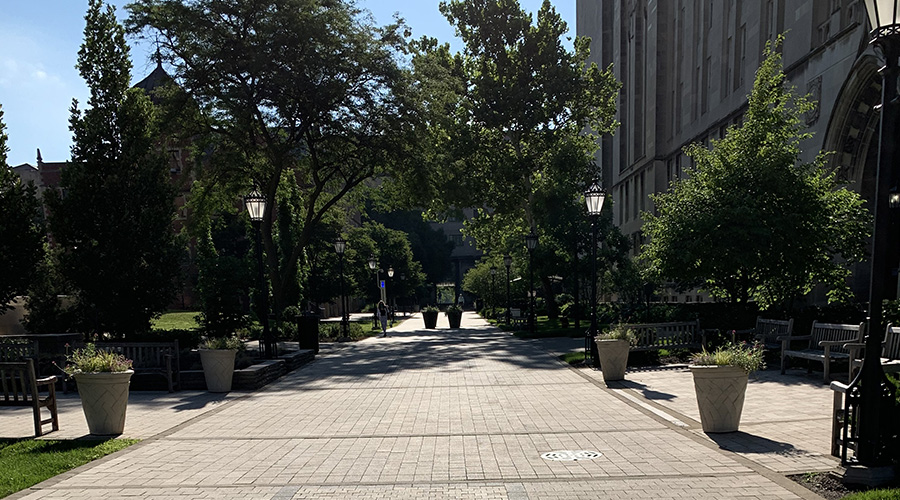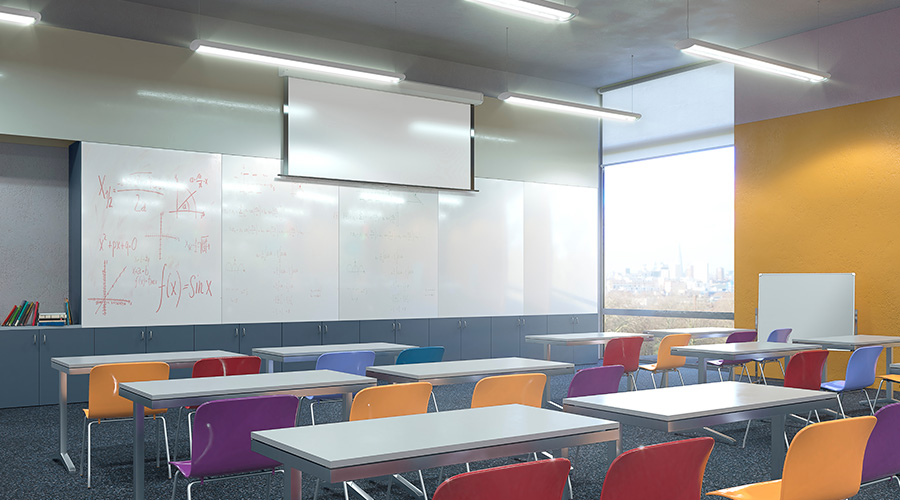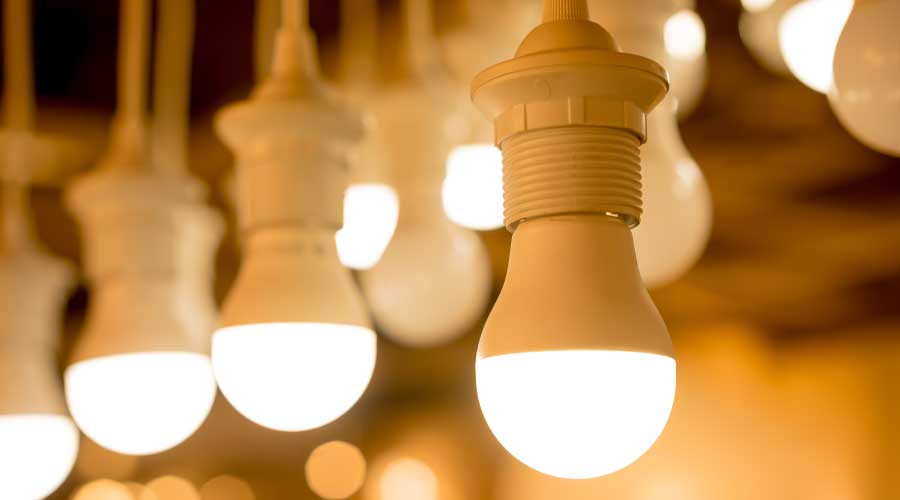Lighting Part II: Maintenance Matters
Strategic relamping and cleaning ensure that lighting systems deliver quality light and operate efficiently
Lighting technology continues to improve the quality and efficiency of lighting systems, but the proper maintenance of installed lighting-system components remains an essential element in ensuring that systems perform as designed.
The key components of a comprehensive program of lighting-system-maintenance include repairing, replacing, relamping and cleaning. Coordinating these efforts can produce system performance that delivers the desired lighting and extends the life of system components.
Deadlines Approach
Maintenance and engineering managers who plan ahead and anticipate future changes will keep a good maintenance plan on track. For example, those who have put off upgrading fluorescent systems from T12 to T8 lamps should start planning now because important deadlines are approaching.
According to the federal ballast rule, which promotes T8 electronic systems without creating efficiency standards for T8 ballasts, magnetic ballasts may not be manufactured for covered T12 lamps — 2-foot U-tubes, 4-foot RS, 2-foot IS, and 8-foot high-output lamps — after June 30, 2005. Magnetic ballasts for replacement purposes in existing installations can be manufactured until June 30, 2010, and will be marked “For Replacement Use Only”
Manufacturers can continue to produce magnetic ballasts for T8 lamps for applications sensitive to infrared (IR) or electromagnetic (EM) interference. Although magnetic ballasts will not be available for T12 lamps after 2010, T12 replacement lamps probably will be available for many years after that date.
To avoid a mix of T12 and T8 lamps, managers will need to convert T12 systems before June 30, 2010. Otherwise, they will have to use T8 ballasts and lamps for spot replacement in T12 magnetic installations. This will result in compatibility problems and a real maintenance headache.
Spot and Group Relamping
Managers also must be aware of several considerations related to scheduling maintenance procedures to minimize interruptions to facility operations. Because of increased concerns for employee safety and security since 9-11, many organizations have placed a higher priority on keeping exterior lighting systems well maintained.
But maintenance personnel can unintentionally increase an organization’s electric bill by turning on outdoor lighting systems during the day to locate burned out lamps. This procedure can set new peak demand levels, which in turn can raise bills for the month in which they occur, and, with some electric rates, for several months beyond that. Managers should plan maintenance of outdoor lighting-systems to avoid peak periods.
Managers might want to consider contracting with a lighting management company offering a program designed to curtail such additional costs. Here is the way such programs work: The management company identifies customers’ poles and numbers them.
Each night, trained and certified technicians drive around roadways and parking lots of selected customers and record each pole position that has burned-out lamps. The next day, each customer receives a fax report identifying the locations that have burnouts. Customers then can authorize replacements at that time or later.
Another way to avoid additional demand charges from turning on exterior systems during the day is to provide a lockout design using time clocks or a building management system to prevent manual operation of systems during peak-demand periods. The drawback to this method is that technicians can bypass the lockout design, defeating the control.
Scheduling lamp replacements can reduce labor costs. Group relamping of large sections of a facility at one time can provide many benefits to facilities, including lower labor costs, higher and more consistent light output, fewer unreplaced burnouts, lower lamp inventory, and fewer work interruptions.
Some corporations have studied the cost of lost productivity resulting from crews changing burned out lamps during normal working hours, and they have decided that spot relamping is a high-cost method of changing lamps. For them, the major benefit of group relamping is productivity gains that result from fewer work interruptions.
Managers can calculate the group relamping interval (GRI) by multiplying the average rated lamp life at actual burn cycle by the percent rated life, the dividing the product by the lighting system’s annual burn hours.
Managers also might consider a simpler method of determining relamping time that is self-calibrating and does not require exact lamp-life or burn-hours data. This method calls for the purchase of more lamps than required to group re-lamp an area. Managers have to control and limit the use of the overstock to spot relamping only the area designated.
When the overstock supply is depleted, it is time to group relamp again. When group relamping at 70 percent rated life, the lamp mortality chart indicates that 10 percent more lamps would need to be purchased. The recommended point for relamping is usually at 70 percent rated lamp life. This point corresponds to a 90 percent survival rate — 10 percent burnout rate — on the lamp mortality curve.
Managers can select other rates by using the accompanying chart
Outdoor Lighting
Outdoor lighting often is neglected, but with increasing concerns for safety and security, maintenance managers also need to keep their outdoor lighting systems well maintained. Controls, especially photocells, frequently are not kept operational.
The least expensive type of photocell uses cadmium sulfide cells that can fail and keep exterior lighting on during the day. They also can degrade from exposure to sunlight and lose sensitivity after a few years of service. This loss of sensitivity cuts into savings by keeping exterior lighting on longer than necessary.
Managers should pay particular attention to the direction photocells are aimed. Photocells should be aimed north so they can detect the reflected light of the north sky, and so they are not affected by the east/west exposure or degraded by intense southern exposure.
Workers can replace inexpensive, cadmium sulfide photocells when replacing high-intensity discharge (HID) lamps they control. The reason for this tactic is to prevent operation of outdoor lighting during the day, as well as the loss of savings that result from degraded cells.
When outdoor lighting controlled by photocells is on during daylight hours, the photocell usually has failed because photocells fail on, or fail-safe, resulting in higher-than-normal electricity bills.
To avoid this scenario, managers can specify that cadmium sulfide cells be replaced with electronic type cells that use solid-state technology but do not lose sensitivity over time. Solid-state photocells that use silicon cells last longer as indicated by their longer warranties and easily pay back before that time with energy and labor savings.
A low-cost way to reduce the maintenance cost of outdoor high-pressure sodium (HPS) systems is to use double arc tube, or standby, lamps instead of standard HPS lamps. These lamps are socket replacements for standard HPS lamps and are available in seven wattages from 70–1,000W.
Using these lamps extends the average rated life from 24,000 hours to more than 40,000 hours, considerably reducing lamp replacement labor cost. Labor savings easily pay for additional lamp costs.
Managers who implement these common-sense maintenance procedures can reduce lighting system costs and ensure that lighting systems provide the quality of light for which they were designed.
Lamp Mortality Curve
with recommended relamping point

Back to article link
Source: Effective Lighting Solutions, Inc. Matthew Fetters, Illustrator
|
Related Topics:












